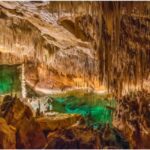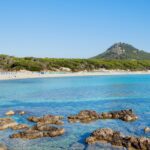Join us in exploring the most beautiful villages of Mallorca and discover the history hidden behind its cobbled streets. Do you want to uncover what each of these charming villages in Mallorca holds? Keep reading!
Here Are the Most Beautiful Towns in Mallorca
Alcudia
Alcúdia, a charming corner of Mallorca, stands out for its privileged location on the northwest coast of the island. This tourist destination, which is very busy in summer, attracts visitors with its unique mix of beaches, history, and culture. The city is situated in a sheltered bay, where the crystal-clear waters and fine sand create a dreamlike setting. Among its gems are the island’s most popular beaches, each with its own history and charm: Playa de Alcudia, Playa de Muro, and Playa Sant Joan. These beaches are not only a delight for the senses but also boast fascinating stories and details, explored in specific articles on this blog.
The old town of Alcúdia is a charming place to take a stroll, with its narrow streets lined by historic buildings, some of which date back to Roman times. Here, you’ll also find the neo-Gothic style church of Sant Jaume, one of the city’s most emblematic buildings.
Alcúdia also has a rich history, as its origins trace back to the Roman Empire of the 1st century BC, and it was an important commercial centre during the Middle Ages. Today, the city preserves remnants of its Roman and medieval past, such as the Roman amphitheatre and medieval walls.
In addition to its beaches, history, and culture, Alcúdia offers a variety of activities for visitors. There are numerous shops, restaurants, and bars, as well as a golf course, a water park, and a lagoon.
Alcudia has been classified as one of the most beautiful villages of Spain by the association of the most beautiful villages of Spain. Currently only three villages in Mallorca have this certificate.
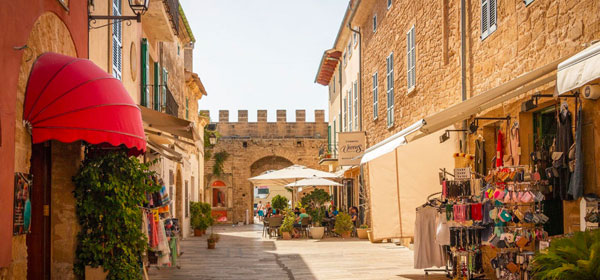

Deià
Deià, also located in the Serra de Tramuntana, is a picturesque corner of Mallorca. Is situated in the Serra de Tramuntana region and borders the municipalities of Valldemossa, Sóller, and Bunyola.
Its architecture mainly consists of traditional stone-built estates, spanning five kilometres of coastline. The village is built on a hill situated in a valley of the Sierra, with the Puig del Teix rising above the landscape.
The history of Deià dates back to the Muslim occupation between the 10th and 13th centuries, when terraces and irrigation systems began to be constructed, leading to successful agricultural development in the region. After the Muslim defeat by the Christians in the 13th century, the town was given to Rossell, as part of neighbouring Valldemossa, and did not become independent until the 16th century.
Deià has been home to artists such as the English poet Robert Graves and the surrealist painter Esteban Francés. The Robert Graves House Museum, as well as other museums in the area, offer a unique insight into the lives and works of these figures.
In addition to its exceptional environment, Deià is known for hosting the International Festival of Deià, an annual event that attracts classical music enthusiasts. The artistic and bohemian life has flourished in the town since the 1960s and 70s, turning it into a haven for artists and writers seeking inspiration.
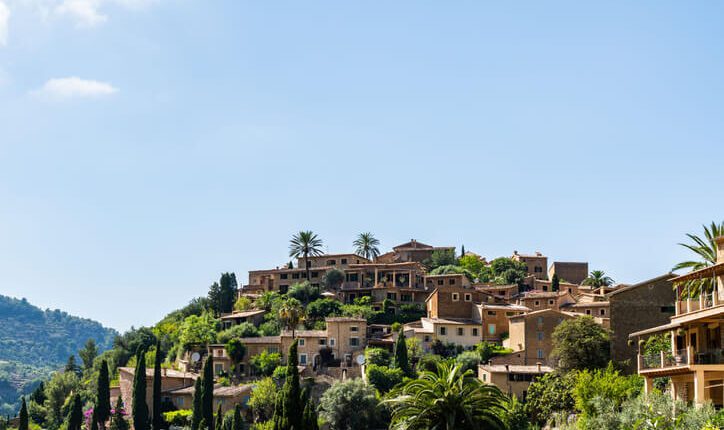

Sóller
Sóller, located on the northwest coast of Mallorca, offers a rich blend of history and lush landscapes. Surrounded by mountains and orange groves, this town is noted for its modernist architecture. The history of Sóller dates back to the Talayotic culture, with remnants dating from 5200 BC to 2700 BC. In 1561, the town withstood a corsair attack, an event annually commemorated in the Firó festival. The Torre Picada and the castle of the Port of Sóller were erected in response to this threat.
During the 19th and 20th centuries, Sóller underwent significant socio-economic changes, marked by emigration and transformations in its urban and cultural structure. These periods witnessed events that shaped the identity of Sóller, preparing it for a new era.
In the 19th century, emigration was a reality that affected many communities in Mallorca, and Sóller was no exception. Many inhabitants sought opportunities elsewhere, contributing to the Mallorcan diaspora. This phenomenon influenced the demographics and social dynamics of Sóller, leaving a mark on the community.
The start of tourism was a pivotal change that began in the early 20th century. In 1912, the inauguration of the Palma railway connected Sóller with the island’s capital and facilitated access for visitors. This milestone not only improved connectivity but also put Sóller on the map as an emerging tourist destination.
Later, in 1997, the inauguration of the tunnel connecting Palma to Sóller marked another key milestone in transportation infrastructure and further consolidated Sóller’s position as a prominent tourist destination in Mallorca.
Sóller has maintained its historic charm through its festivities, such as the festival of San Bartolomé and the Firó. Today, its economy is primarily fueled by tourism, although agriculture, highlighted by the famous Sóller oranges, remains an integral part of local life.
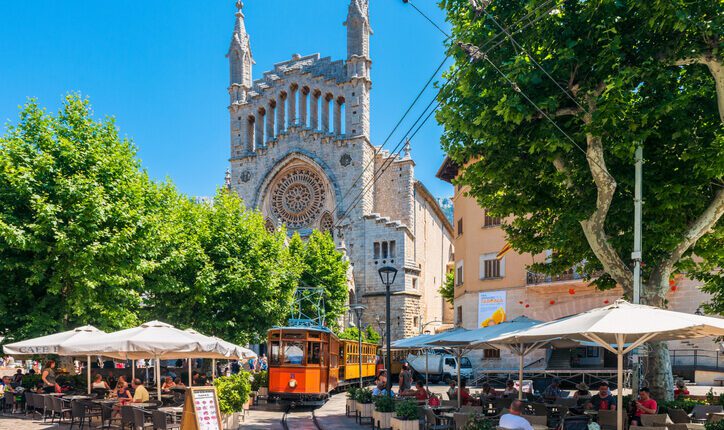

Pollença
Pollença, situated along the Mediterranean coast, borders the municipalities of Escorca, Campanet, La Puebla, and Alcúdia.
With 17,126 inhabitants, Pollença has been a source of inspiration for artists like Costa y Llobera, Winston Churchill, and Agatha Christie. Its charm is evident in landmarks such as the Roman Bridge and the Calvary.
The natural landscape of Pollença, particularly visible in Cape Formentor, showcases a rich botanical diversity with native species like the wild olive tree and the dwarf palm.
Culturally, Pollença stands out for its artistic legacy since the early 20th century, remaining relevant with events like the International Music Festival and the Pollença Museum. The song “Puerto Pollensa” by Marilina Ross celebrates the inspiration that the port provided during her exile.
The local cuisine reflects Mediterranean tradition with dishes such as sobrasadas, pa amb oli, tumbet, arroz brut, and delights like ensaimada in pastry. Moreover, Mallorca prides itself on its wine tradition and liqueurs like palo and hierbas.
Pollença is another of the villages that has been classified as one of the most beautiful villages in Spain by the association of the most beautiful villages in Spain. That is why it is a destination not to be missed.
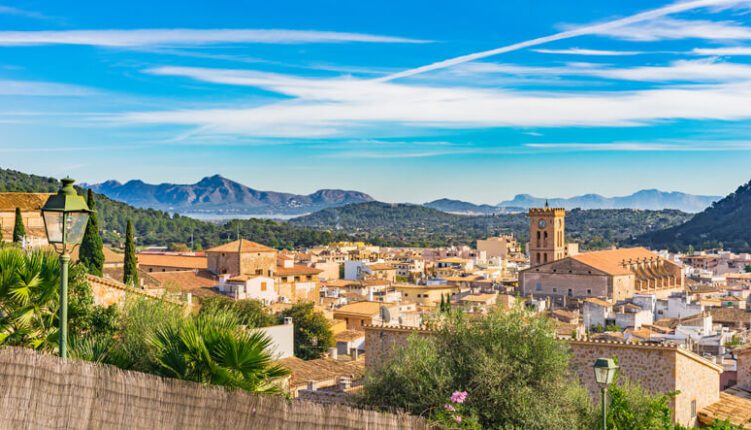

Fornalutx
Fornalutx is located in the Serra de Tramuntana region and borders the municipalities of Sóller and Escorca, nestled in the idyllic Sóller Valley.
Fornalutx, located in the Serra de Tramuntana region and bordering the municipalities of Sóller and Escorca, resides in the idyllic Sóller Valley. Its stunning landscape has earned it a place in the exclusive Association of The Most Beautiful Villages of Spain.
The village has been recognised with awards such as the “Silver Plaque for the Promotion of Tourism in Mallorca for the Defense and Maintenance of the Town” and the “Second National Prize for Beautified and Maintained Villages of Spain.”
Additionally, in 1995, it received the “Premi Alzina” for its outstanding efforts in favour of nature. Fornalutx stands out not only for its rich history but also for its commitment to preservation.
It also received the certificate of one of the most beautiful villages in Spain.
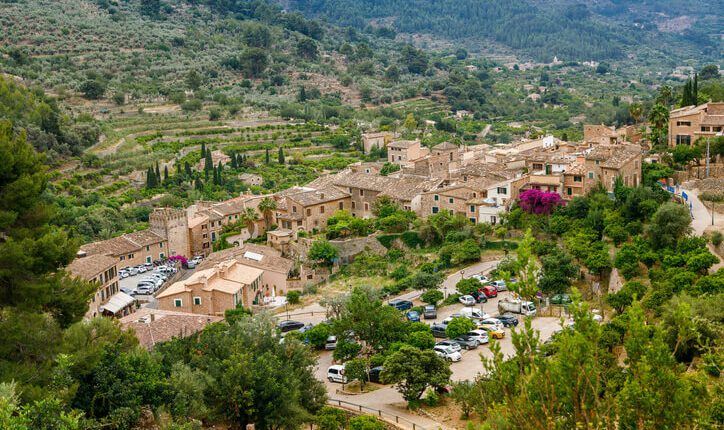

Valldemosa
Valldemossa, the Mallorca village that National Geographic has crowned the most beautiful, is an enchanting corner of Spain where the essence of the Mediterranean comes to life amidst historic streets and dreamy natural landscapes.
Situated in the Tramuntana mountain range, this village combines history, culture and stunning natural beauty, offering panoramic views of mountains and Mediterranean vegetation.
Valldemossa’s architecture reflects Mallorca’s rich history and character, with cobbled streets and houses adorned with flowers and tiles that tell the stories of Santa Catalina Tomas. The Royal Charterhouse, with its neoclassical church and frescoes by Bayeu, is a living testimony to the monastic and royal history of the place.
Strolling through Valldemossa is a unique sensory experience, where every street and square hides stories and a particular beauty. The influence of Chopin and Sand turned the town into a cultural centre, and today visitors can explore the cell where they lived, while Chopin’s music seems to echo through the streets.
Although Valldemossa is known for its mountainous location, it also has a connection to the sea through its small but significant harbour. With its rich history, stunning natural surroundings and vibrant cultural life, Valldemossa is truly a treasure in the heart of Mallorca.
Discovering the Island and Beautiful Villages of Mallorca
If you’re looking to immerse yourself in the authentic side of Mallorca, these villages offer a unique experience. From the serenity of Valldemossa to the bohemian charm of Deià, each corner has its own story to tell.
Explore the essence of Mallorca through its charming villages and let Ideal Property Mallorca make your stay unforgettable with its wide selection of apartments and tourist villas.

